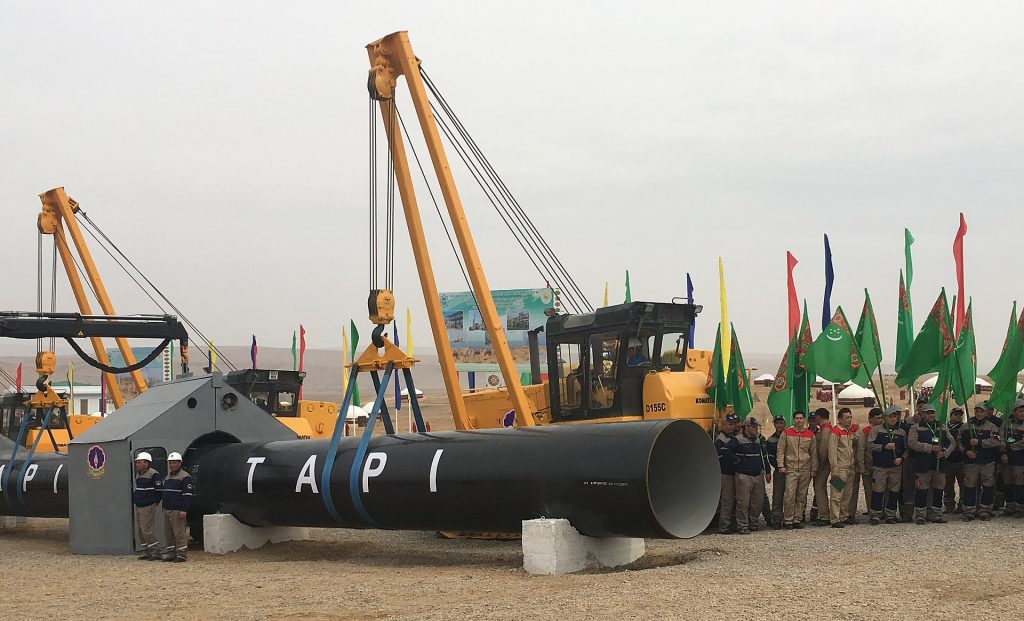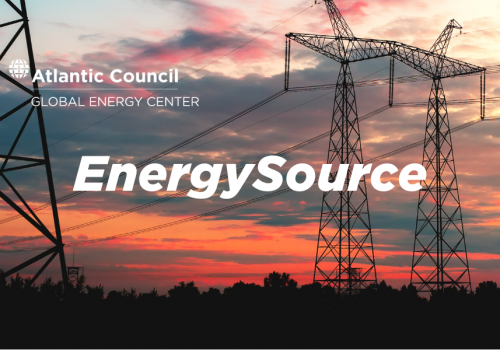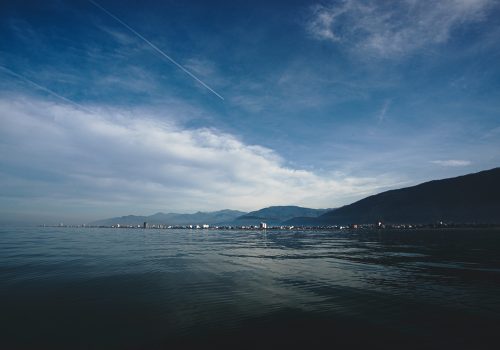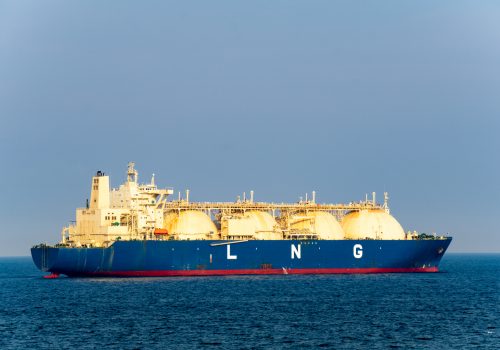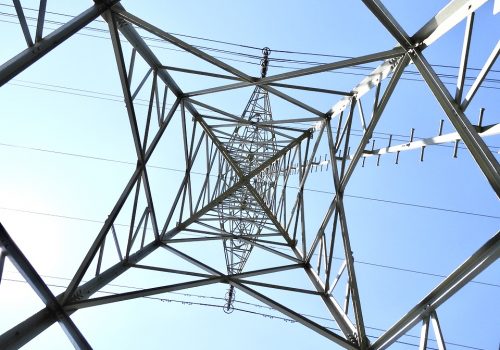The Taliban’s ascent is driving renewed discussion about the Turkmenistan-Afghanistan-Pakistan-India (TAPI) gas pipeline. Taliban spokesman Suhail Shaheen said on August 18 that TAPI is a “long-term priority project” that the Taliban fully supports. Taliban representatives also visited Ashgabat, Turkmenistan in February 2021 and offered assurances of support for the project.
Since the fall of the Soviet Union, energy companies have pondered routes to send natural gas from gas-abundant yet land-locked Turkmenistan to energy-poor Pakistan and onward to India. The Berdimuhamedov government of Turkmenistan and the Asian Development Bank (ADB) have made this pipeline a priority for years, but it has long been on life support, with the project’s press releases failing to obscure its grim deficits. The advent of the Taliban, though, changes the TAPI calculations in ways both positive and negative for the project.
Early attempts
The 1990s saw fierce competition over the proposed pipeline, as rival consortia jockeyed to ship gas south from Turkmenistan. A group led by US-based Unocal, and including Gazprom and Itochu, won the rights to the project and, in the late ’90s, held talks in Kabul and Ashgabat with the Taliban, who ruled Afghanistan at the time. Unocal even brought Taliban representatives to its company headquarters in Houston for negotiations. TAP—India was not part of the original project—was envisioned as a major gas transport route, sending 20 billion cubic meters per year to downstream consumers. However, as US hostility to the Taliban increased, Unocal withdrew from the project in late 1998. The consortium dissipated and TAP hopes vanished.
The 2001 US invasion of Afghanistan and the fall of the Taliban government sparked new interest in the project, but the policies of Turkmenistan’s then-President Niyazov’s government were hostile to investment and discouraged foreign companies from taking part. The 2007 ascension of Gurbanguliy Berdimuhammedov to the Turkmen presidency offered new hope to investors and, in 2010, US energy giants ExxonMobil and Chevron opened offices in Ashgabat to pursue upstream opportunities in Turkmenistan. Turkmengaz and the ADB, meanwhile, now envisioned including India in a TAPI pipeline, with throughput rising to 33 billion cubic meters per year (BCMA).
Fundamental logic
TAPI makes sense on paper. Pakistan’s need for energy has never been in doubt, and the Pakistan market is large. India could benefit as well from a new gas source, but prospects are riskier. India will only buy TAPI gas if the landed price beats the price India pays for liquefied natural gas. Bilateral hostility also may raise its head. Indian lawmakers have asked pointed questions about the transit fees which Pakistan would collect from supplying gas to India, while any Pakistani government might be tempted to squeeze gas supplies during a time of tension. Nevertheless, India and Pakistan have partnered with the Afghan government and Turkmenistan in forming an investors’ consortium to build the pipeline.
TAPI would certainly benefit Afghanistan, more from transit fees than from actual supply of gas. Afghanistan has next to nothing in the way of power generation facilities and distribution networks that could actually use natural gas, but the transit fees from a pipeline—along with the potential for bribes and kickbacks during construction and operation—would be very welcome to national and regional rulers. A successful pipeline would also be a “flagship” project, which would speak well to investment stability in Afghanistan.
But Turkmenistan would benefit most of all. The country has long since lost Gazprom as a major customer, as Russia has prioritized its own upstream development. In 1991—the year of the Soviet breakup—the Turkmen SSR shipped 89 BCM to Russian and Ukrainian consumers. That amount dwindled through the 1990s, and Turkmenistan now only sells a few BCMA northwards. Iran has always been a small-change customer, consuming a few BCMA, but that commercial relationship is fraught with disputes, and sales are currently closed. China has been Turkmenistan’s economic savior, buying an estimated 30 BCMA; however, the financial details of these transactions are a black box. With China as Turkmenistan’s sole substantial customer, and given China’s numerous other sources of gas supply, pricing leverage lies entirely with the Chinese. There is little doubt that Turkmenistan has the gas reserves to export far more than it does now. Thus, TAPI makes, and has always made, great sense for Ashgabat, even more so in light of the country’s extraordinary economic woes.
What stands in the way?
Conventional wisdom has viewed security as the greatest obstacle to TAPI. Investment is risk-averse, and hydrocarbon pipeline projects, spanning long distances, are tempting targets for insurgents, while the costs of policing every meter of pipeline are prohibitive. A nation in which combat operations have greatly diminished should curb security risks to TAPI. Indeed, the Taliban has repeatedly offered to guarantee the pipeline’s safety.
Yet security is not the pivotal issue. Pipeline financing, far more than security, is the main obstacle to TAPI. A pipeline price tag of $10 billion for a full-scale TAPI was commonly quoted by the ADB and by regional governments. This was likely a back-of-the-envelope figure which underestimates the cost; Western industry experts consider $14-16 billion to be more realistic. This tally, moreover, omits upstream costs, which will be considerable if TAPI is to supply anywhere near the envisioned 33 BCMA. These upstream costs could add another $16 billion to the overall project balance sheet. Finally, any project needs to address potential cost overruns and have accessible funding for that contingency. It is very reasonable to view TAPI as a $40 billion project.
Commercial banks and private sector energy companies have given the coldest of cold shoulders to the project despite years of investment road shows in New York, Singapore, London, and other destinations. The failure to attract international oil companies meant that Turkmengaz was forced to take the consortium lead, and Turkmengaz has no project track record or creditworthiness that would give lenders the confidence to provide funding. A pipeline through war-torn Afghanistan added to the disincentives. Even if banks decided to lend, how would they price the risk? Afghanistan is near-virgin territory for private sector infrastructure projects, and having the Taliban as a counterparty adds a near-insurmountable degree of risk, with the group under severe US sanctions. This makes it even more unlikely that an international oil company will touch the project, given the legal and reputational downsides.
There also remains a tough question about the bankability of the project. TAPI economics depend on reliable payment for the gas shipments, but Pakistan has a woeful record on energy payments. Turkmengaz may still come out ahead even with partial and sporadic payment from Pakistani consumers; a thin incremental revenue stream may be preferable to the current state of play. Sporadic payments are not, however, acceptable to any international lenders, and the Pakistan payment question will further depress the prospects for loans.
This persistent failure to attract financing has forced the project’s proponents to scale TAPI down, from 33 BCMA to a stated 11 BCMA throughput, with the project cost now listed as $7.7 billion. Instead of using six compressor stations, the current “Phase 1” concept of TAPI proposes to send gas via a “free flow” model, involving compression only in the upstream and no expensive compressor stations along the Afghanistan-to-Pakistan route.
Even with these cutbacks, the project is strapped for cash. The ADB has indicated it will contribute $1 billion in loans. The Turkmen government, grappling with a massive economic crisis, has risibly pledged $1.675 billion. The remainder is envisioned to come from export credit agencies and commercial lenders, all lending individually to the four governments and relying on sovereign guarantees from each country. What is an Afghan sovereign guarantee worth? Or a Turkmen? It strains credulity that an institution like the ADB would agree to this arrangement. In contrast, the European Bank for Reconstruction and Development, which also has Turkmenistan in its purview, has long kept its distance from TAPI.
An additional crippling factor for TAPI is the management structure Ashgabat has imposed on the project. Instead of one unified project management company, the Turkmen government has decreed that there will be four separate pipeline companies, one for each country, each constructing, owning, and operating their own segment of the pipeline. It is hard to imagine a more dysfunctional structure.
Occasional photos of construction have surfaced, along with rosy assertions of progress, but there is no reason to believe that the project is anywhere near completion. In contrast, the South Caucasus Pipeline from Baku to Erzurum was completed in twenty-eight months.
Can TAPI succeed in its originally envisioned, 33-BCMA-or-greater form? Hardly, given the managerial structure, the sanctions and financing challenges, and the absence of substantial private sector participation. Successful pipeline projects begin in the upstream. They require a commercial champion: an international company with the managerial and technical skill, along with the financial clout, to drive the project to completion. BP played this role for the Baku-Tbilisi-Ceyhan and the South Caucasus pipelines. Chevron drove the Caspian Pipeline Consortium forward. India’s state gas company GAIL is a TAPI participant, but GAIL has chosen to play a very small role, commensurate with India’s minor participation in the project. Russian companies have made noise about investment from time to time, but Gazprom and Novatek have their hands full with pipelines to Europe and China and new liquefied natural gas plants. It is hard to see the attractions of expensive investment in a marginal project outside Russian borders, and where they have no upstream equity. Without a credible commercial champion, TAPI will continue to struggle. But there are two scenarios in which a TAPI of some sort might take shape.
Potemkin TAPI
If the measure of success is simply the creation of a pipeline link across national boundaries, then a nominal TAPI may be achievable. The distance from the Turkmen border to Herat, Afghanistan, is a mere 130 kilometers, and it would not take great amounts of money to build the pipeline such a short distance and send gas via free flow. Indeed, this looks to be the default strategy of the existing consortium. Yet it is questionable whether Herat has or will have the gas infrastructure to actually use the gas. And even if Herat develops gas-fired electricity generating capacity in the coming years, it is doubtful that any authorities in Herat would have steady funds to pay for gas offtake. Yes, TAPI transit fees could fund Afghan gas purchases, but a prerequisite for garnering those fees is a pipeline that sells into Pakistan and India, not a simple Turkmen-Afghan link. The next leg from Herat to Quetta, Pakistan, and thus the greater Pakistani market, is 800 kilometers, and far more challenging and expensive, so Herat may be as far as the project gets. Phase 1 therefore may turn out to be no more than steel in the ground.
Completion of Turkmen-Herat construction would be enough to trigger articles noting TAPI’s long-delayed realization, along with celebrations driven by a Turkmen regime desperate to showcase a success against a grim domestic economic backdrop. A Potemkin TAPI would resemble the early Odessa-Brody oil pipeline, which was completed by the Ukrainian government and then stood empty because of lack of a commercial rationale.
Political TAPI
If China decides to invest in TAPI, the pipeline could come to life. China has easy entrée to Ashgabat and Islamabad, and the Taliban will listen attentively. China could certainly commit the funds and the manpower to construct a true export route beyond Afghanistan and into Pakistan and have it poised for future India supply. A leading Chinese role would raise concerns for Indian politicians, but India has always been a small-equity, late-phase player in this project, so China would be able to proceed undeterred.
China would not care about sanctions on the Taliban. Beijing would no doubt insist on a unifying managerial role, in practice if not on paper, to make the pipeline functional. The question is, why would China do this? The project economics are risky, given the uncertainty of payment for gas shipped to Afghanistan and Pakistan. Return on investment might be positive, assuming cut-rate prices for Turkmen gas and cut-corner construction on the pipeline itself, but that is by no means clear. Without a solid understanding of upstream and construction costs alike, the participants in TAPI could find themselves facing negative netbacks.
Geopolitics is a more plausible motive than profit for Beijing to undertake TAPI, but China already enjoys longstanding leverage in Turkmenistan and Pakistan. The incremental political gain for China would be slight, and thus the odds of political TAPI may be long indeed.
Conclusion
If China chooses not to step in, then look for continued wheel-spinning or, at best, a Potemkin TAPI. Meanwhile, the ADB will continue to jolly the Turkmen along, and Turkmen officials, fearing the wrath of Berdimuhammedov, will keep staging photo ops and hoping for the day when even minimal volumes make it across the border to Afghanistan.
Will a Taliban victory advance TAPI? In one regard, the answer is yes: the end of large-scale combat in Afghanistan will ameliorate one of the longstanding obstacles to TAPI, the fear of hostilities preventing construction and impacting pipeline operations. But the ascent of the Taliban will do nothing to address the project’s dire flaws, including financing, bankability, and pipeline ownership and operation. On top of that, the severe sanctions on the Taliban introduce a new deal-breaker. As has been the case with the Trans-Caspian Pipeline, Turkmen insistence on unworkable governance and financing structures has caused delays and intensified downstream competition.
The ADB and other project participants have, at Turkmen insistence, treated TAPI as if it is exempt from the commercial and operational logic that applies to other oil and gas export pipelines. It isn’t, and at this juncture, Washington, as the largest shareholder—along with Japan—in the ADB, needs to reorient its stance to reflect that reality. It can either use the ADB’s support for TAPI as (admittedly modest) leverage on the new Kabul regime—though TAPI support may in any case now be legally impossible—or, more productively, it can join with other shareholders and have the Bank prioritize Turkmen investment reforms that might actually attract serious private sector players to gas export projects.
Steven Mann is a retired American diplomat and former ambassador to Turkmenistan. From 2009 to 2020, he was a senior advisor with ExxonMobil Corporation.
Related content
Learn more about the Global Energy Center
Image: Completion ceremony for the Turkmen section of the Turkmenistan-Afghanistan-Pakistan-India natural gas pipeline. (Allan Mustard, Wikimedia, Creative Commons Attribution-Share Alike 4.0 International) https://creativecommons.org/licenses/by-sa/4.0/
